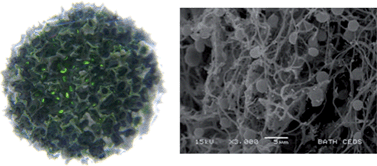Porous ceramic anode materials for photo-microbial fuel cells
Abstract
This study focuses on porous ceramics as a promising new type of anode material for photo-microbial

* Corresponding authors
a
Department of Chemistry, University of Bath, UK
E-mail:
p.j.cameron@bath.ac.uk
Fax: +44(0) 1225 386231
Tel: +44 (0) 1225 386444
b Department of Chemical Engineering and Biotechnology, University of Cambridge, UK
c Department of Mechanical Engineering, University of Bath, UK
This study focuses on porous ceramics as a promising new type of anode material for photo-microbial

 Please wait while we load your content...
Something went wrong. Try again?
Please wait while we load your content...
Something went wrong. Try again?
R. Thorne, H. Hu, K. Schneider, P. Bombelli, A. Fisher, L. M. Peter, A. Dent and P. J. Cameron, J. Mater. Chem., 2011, 21, 18055 DOI: 10.1039/C1JM13058G
To request permission to reproduce material from this article, please go to the Copyright Clearance Center request page.
If you are an author contributing to an RSC publication, you do not need to request permission provided correct acknowledgement is given.
If you are the author of this article, you do not need to request permission to reproduce figures and diagrams provided correct acknowledgement is given. If you want to reproduce the whole article in a third-party publication (excluding your thesis/dissertation for which permission is not required) please go to the Copyright Clearance Center request page.
Read more about how to correctly acknowledge RSC content.
 Fetching data from CrossRef.
Fetching data from CrossRef.
This may take some time to load.
Loading related content
